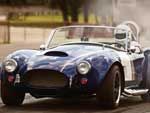
By definition, a Factory Five Cobra is a kit car. You pay a set price, and at some point in time a big brown truck pulls up to your house and unloads a couple of very large boxes full of parts made of fiberglass and steel. But for decades, "kit car" meant missing parts, shoddy workmanship, horrible chopper-gun fiberglass, and a bundle of parts destined to gather dust in the garage with no realistic hope of getting put together. If that's how you define a kit car--and many people do--then a Factory Five Cobra needs a different label, as it comes complete as advertised, and if you can't finish it in a year or so ... well, you're just not trying.
Factory Five Racing (FFR) owner David Smith realizes that the general public views his Cobra roadster as a kit car, but he has no shortage of customer referrals to debunk the negativity of that label. And after touring the factory, driving several different variations on the FFR Cobra, following along as Muscle Car Restorations (MCR) built one for us, and talking to many of the customers who have built cars by themselves, it's pretty obvious that FFR is in another league, rising far above the stigma that has befallen kit cars since those dark days of the VW Bug-based trash that belittled the genre.
The basic premise behind the FFR Cobra is light years ahead of the competition. For about $15,000, you buy the parts to build a Cobra, minus the suspension, drivetrain, wiring, and some other small pieces. Those missing parts, however, come from the darling of the aftermarket and junkyards alike--every Mustang built between 1979 and 2004. Get a wrecked 5.0 or 4.6 Mustang and rob the suspension, engine, transmission, wiring, and some other minor parts, and you have all that's necessary to build a basic FFR Cobra. It really doesn't get much easier, considering you're building a car from scratch.
To prove the durability of his cars, Smith worked out a deal with HOT ROD wherein we would build one of his cars to our own specs, and then thrash the living bejeezus out of it at our bidding. So we took him on and had a kit delivered to the anal-retentive (and we say that in the most kind way) pros at Muscle Car Restorations in Wisconsin. Over the course of only a few months, MCR's John Balow and his boys turned our FFR Cobra from three boxes of parts into a running, driving, fire-breathing Cobra that would make Carroll Shelby if not proud, at least a little jealous.
We'll let the cat out of the bag and tell you that the car is already done as we go to press with this issue. Did it live up to its reputation? You'll have to wait until next month to learn that. This month, we'll show you what's involved in building one of these cars yourself in your own garage.
Before we gild the lily too much, understand that you need to know your way around a wrench and rivet gun before taking on a project of this sort, but you also don't need to be a NASCAR Cup-level fabricator. It's a little bit beyond a complete bolt-together deal, and there are a few things that you'll probably need to farm out, most notably bodywork and paint. But it's certainly something that the average hot rodder can accomplish. And since it's much easier to build one of these cars after you've already done it before, FFR sponsors a three-day class at Mott community college in Howell, Michigan, where students go through the process of building one. Students range from professional mechanics to soccer moms, so you don't need to be intimidated.
The following is an abbreviated look into what it takes to build an FFR Cobra roadster, as done by the Muscle Car Restorations crew. Check back next month when we put the finished car on the chassis dyno, on the road, on the dragstrip, and around a few curves at speed.